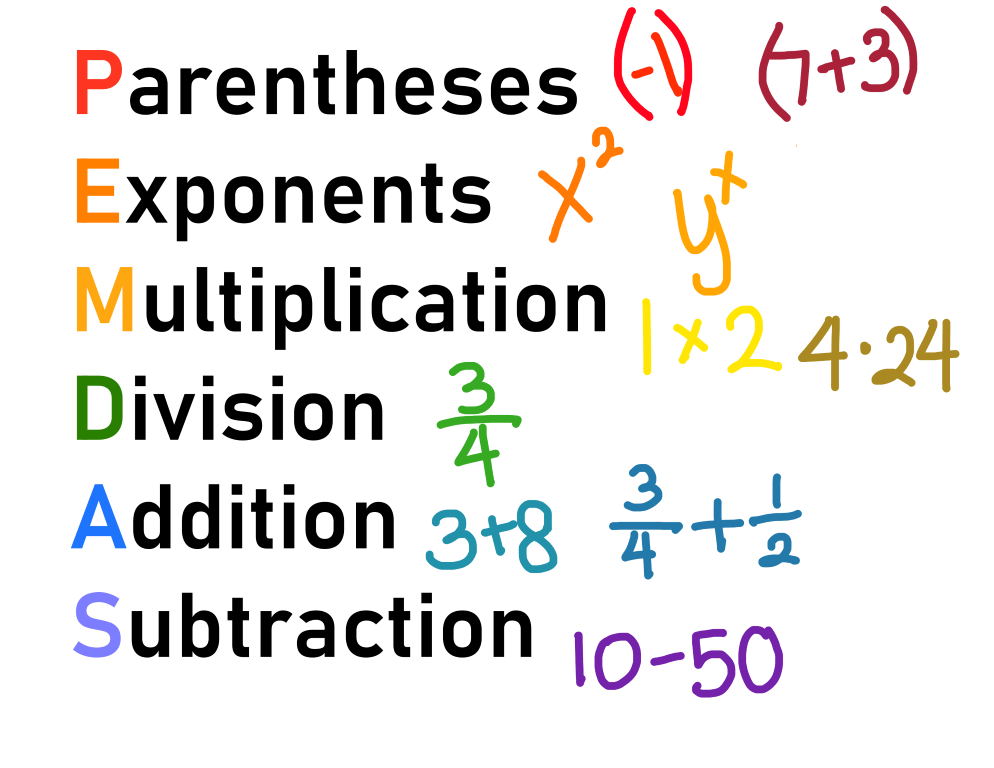
The Order of Operations
What’s the order?
Suppose we are given 3(1+2) – 7 + 43 to solve. There are many types of mathematical operations involved – multiplication, addition, subtraction, exponents, AND parentheses. Hence, the question arises: what do we do first?
The order of operations is a set of rules we must follow to get the correct answer to a mathematical statement, telling us which operations to perform first when multiple are involved. This can kick in to help us solve the problem above! You should always use this order unless specified otherwise.

The first letters write “PEMDAS”, the acronym used. You can easily switch the ‘m’ and ‘d’ to get “PEDMAS” because this exact order is not significant. More will be explained below!
Detailing the Steps
Parentheses
From the diagram in the introduction, we can see that the first letter, ‘p’, stands for parentheses. This means that when you see parentheses (), you do the operations inside them first before everything else.
- For instance, if we have the equation (1 + 2) * 3, we do 1 + 2 = 3 first, then do 3 * 3 and get 9. If we did not follow the order of operations and did 2 * 3 = 6, 6 + 1 = 7, we would get a totally different answer – which is incorrect. Make sure to follow the order!
Exponents
The next point is exponents. After you have made sure to take care of all operations inside parentheses, you carry out the exponents. We should carry this out first before doing the four basic operations, but only after we take care of anything inside parentheses.
- Therefore, in 82+4, we would not do 8 + 4 = 12, 122 = 144; but rather, 82 = 64, 64 + 4 = 68. The output changes drastically!
Multiplication
and Division
Now, we have multiplication and division. Since the order of operations must be followed to get the right answers to math problems, then you might be wondering why we can switch the order, as we can use both acronyms “PEMDAS” and “PEDMAS”. This is because division is multiplying by a fraction, so there is a level of flexibility. However, it is a common practice to do multiplication and division in the order that it is written – first come, first serve!
- An example is if we have 2(3) + 3. We would do 2 * 3 = 6 first since the multiplication comes before addition, then add 3, returning the result of 9.
Addition
and Subtraction
The same can be said for addition and subtraction. However, we often don’t switch them in the acronym because we cannot pronounce “PEMDSA” or “PEDMSA” very well. Try it yourself!
- To see the ‘first come, first serve’ policy for addition & subtraction, as well as multiplication & division at work:
- 1 + 2 – 3. First, do 1 + 2 = 3, then 3 – 3 = 0. We did it in the exact order that it appeared! While if you did it the opposite way, with 2 – 3 = -1, then -1 + 1 it would still work, errors may arise in more complicated problems, so it is easier to go from left to right.
- 2 * 4/2 this would give 2 * 4 = 8, then this divided by 2 = 4!
Oops! When the order isn’t followed…
Many of us use calculators to solve difficult math problems, efficiently performing operations. However, some calculators may not know to follow the order of operations! To test your calculator, simply insert 2 – 1 * 3 and see what your calculator gives you. If you get 3, then your calculator does not know the order of operations, whilst if you get -1 then your calculator does know the order of operations. Play around or try something similar!